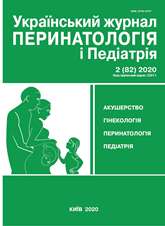Chronic mucocutaneous candidiasis as a nosological form of primary immunodeficiency in children: the case of mucocutaneous candidiasis in a young child
DOI:
https://doi.org/10.15574/PP.2020.82.98Keywords:
immunodeficiency, chronic mucocutaneous, childrenAbstract
Chronic mucocutaneus candidiasis or chronic generalized candidiasis is a primary combined immunodeficiency characterized by persistence of a mucocutaneous fungal infection caused by Candida fungi and is often manifested in children. Modes of its inheritance are autosomal recessive and autosomal dominant with rare sporadic cases. This article contains a clinical case of a chronic mucocutaneus candidiasis in a toddler caused by a gene mutation STATI (GOF).
It has been established that vigilance of doctors regarding clinical and immunological markers of primary immunodeficiency improves early diagnosis and promotes timely adequate therapy, prevents severe and irreversible disorders. And this, in turn, significantly improves the quality of life of patients and the further prognosis of primary immunodeficiency disorders.
References
Blagotvoritelnyiy fond «Podsolnuh». (2020). Chto takoe pervichnyiy immunodefitsit? URL: https://www.fondpodsolnuh.ru/disease/article.xl?id=28967.
MOZ Ukrainy. (2015). Unifikovanyi klinichnyi protokol pervynnoi, vtorynnoi (spetsializovanoi) ta tretynnoi (vysokospetsializovanoi) medychnoi dopomohy. Zahalnyi variabelnyi (pervynnyi) imunodefitsyt. Nakaz MOZ Ukrainy vid 20.01.2015 No. 22. URL: https://dec.gov.ua/wp-content/uploads/images/dodatki/2015_22_ZVID/2015_22_YKPMD_ZVID.pdf.
Chernysheva LI, Bondarenko AV, Volokha AP ta in. (2013). Khronichnyi shkirno-slyzovyi kandydoz yak pervynnyi imunodefitsyt u ditei. Zdorove rebenka. 2 (45): 112—119.
Chernysheva LI, Bondarenko AV, Kostiuchenko LV ta in. (2015). Epidemiolohiia pervynnykh v Ukraini za danymy reiestru patsiientiv. Zdorove rebenka. 7 (67): 16—22.
Shklyarska O. (2018). «Ohmatdet»: spasut li ukrainskih detey inostrannyie vrachi? Racurs.ua. 05.10.2018.
Al-Herz W, Bousfiha A, Casanova J-L et al. (2011). Primary immunodeficiency diseases: an update on the classification from the International Unit of Immunological Societies Expert Committee for Primary Immunodeficiency. Frontiers in Immunology. 2 (54): 1—26.
Bousfiha A, Jeddane L, Picard C, Ailal F, Bobby Gaspar H, AlHerz W, Chatila T, Crow YJ, Cunningham-Rundles C, Etzioni A, Luis J. (2018). J Clin Immunol. 38 (1): 129—143. Published online 2017 Dec 11 https://doi.org/10.1007/s10875-017-0465-8; PMid:29226301 PMCid:PMC5742599.
Chapel H, Prevot J, Gaspar H, Espanol T, Bonilla F, Solis L, Drabwell J. (2014). Primary immune deficiencies – principles of care. Online 2014, Dec 15. https://doi.org/10.3389/fimmu.2014.00627.
Chen X, Xu Q, Li X et al. (2019). Cite as Molecular and Phenotypic Characterization of Nine Patients with STAT1 GOF Mutations in China. First Online: 04 November 2019. Journal of Clinical Immunology: 1—14. https://doi.org/10.1007/s10875-019-00688-3; PMid:31686315
Hori T, Ohnishi H, Teramoto T, Tsubouchi K, Naiki T, Hirose Y et al. (2012). Autosomal-dominant chronic mucocutaneous candidiasis with STAT1-mutation can be complicated with chronic active hepatitis and hypothyroidism. J Clin Immunol. 32: 1213—1220. https://doi.org/10.1007/s10875-012-9744-6; PMid:22847544.
Liu L, Okada S, Kong XF, Kreins AY, Cypowyj S, Abhyankar A et al. (2011). Gain-of-function human STAT1 mutations impair IL-17 immunity and underlie chronic mucocutaneous candidiasis. J Exp Med. 208: 1635-1648. https://doi.org/10.1084/jem.20110958; PMid:21727188 PMCid:PMC3149226.
Picard C, Gaspar HB, Al–Herz W, Bousfiha A, Chatila T, Crow YJ et al. (2017). International Union of Immunological Societies. Primary Immunodeficiency Diseases Committee report on inborn errors of immunity. J Clin Immunol (in Press). https://doi.org/10.1007/s10875-017-0464-9; PMid:29226302 PMCid:PMC5742601
Puel A, Cypowyj S, Bustamante J, Wright JF, Liu L, Lim HK et al. (2011). Chronic mucocutaneous candidiasis in humans with inborn errors of interleukin-17 immunity. Science. 332: 65—68. https://doi.org/10.1126/science.1200439; PMid:21350122 PMCid:PMC3070042.
Puel A, Cypowyj S, Marodi L, Abel L, Picard C, Casanova JL. (2012). Inborn errors of human IL-17 immunity underlie chronic mucocutaneous candidiasis. Curr Opin Allergy Clin Immunol. 12: 616—622. https://doi.org/10.1097/ACI.0b013e328358cc0b; PMid:23026768 PMCid:PMC3538358.
Takezaki S, Yamada M, Kato M, Park MJ, Maruyama M, Yamazaki Y, Chida N, Ohara O, Kobayashi I, Ariga T. (2012). Chronic mucocutaneous candidiasis caused by a gain-of-function mutation in the STAT1 DNA-binding domain. J. Immunol. 189: 1521—1526. https://doi.org/10.4049/jimmunol.1200926; PMid:22730530
Veerdonk FL, Plantinga TS, Hoischen A, Smeekens SP, Joosten LA, Gilissen C et al. (2011). STAT1 mutations in autosomal dominant chronic mucocutaneous candidiasis. N Engl J Med. 365: 54—61. https://doi.org/10.1056/NEJMoa1100102; PMid:21714643.
Yamazaki Y, Yamada M, Kawai T, Morio T, Onodera M, Ueki M, Watanabe N, Takada H, Takezaki S, Chida N, Kobayashi I and Ariga T. (2014). Two Novel Gain-of-Function Mutations of STAT1 Responsible for Chronic Mucocutaneous Candidiasis Disease: Impaired Production of IL-17A and IL-22, and the Presence of Anti-IL-17F Autoantibody. J Immunol November. 193 (10): 4880—4887. https://doi.org/10.4049/jimmunol.1401467; PMid:25288569.
Downloads
Published
Issue
Section
License
The policy of the Journal “Ukrainian Journal of Perinatology and Pediatrics” is compatible with the vast majority of funders' of open access and self-archiving policies. The journal provides immediate open access route being convinced that everyone – not only scientists - can benefit from research results, and publishes articles exclusively under open access distribution, with a Creative Commons Attribution-Noncommercial 4.0 international license(СС BY-NC).
Authors transfer the copyright to the Journal “MODERN PEDIATRICS. UKRAINE” when the manuscript is accepted for publication. Authors declare that this manuscript has not been published nor is under simultaneous consideration for publication elsewhere. After publication, the articles become freely available on-line to the public.
Readers have the right to use, distribute, and reproduce articles in any medium, provided the articles and the journal are properly cited.
The use of published materials for commercial purposes is strongly prohibited.

